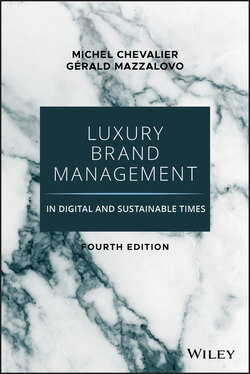Читать книгу Luxury Brand Management in Digital and Sustainable Times - Michel Chevalier - Страница 17
The Advent of Intermediate Luxury
ОглавлениеThis transformation of meaning is based on a contemporary sociological revolution, a direct consequence of the mass production and especially of the rise of the brands: the advent of intermediate luxury. Truly luxurious lifestyles are present, more than ever, in any modern communication: but they form only part of the equation. Intermediate luxury brands offer countless possibilities for the middle class to take part symbolically, partially, or virtually into this world.
The global luxury chessboard is therefore distributed on two levels, if not more: on the one hand, “true luxury”—which few people can afford—increases its hold on the market. The growth of the number of wealthy or well-to-do consumers (especially in the BRIC countries) combined with a bigger supply—investments in the luxury industries that have been yielding higher returns on investment than ordinary brands—have led to a strong visibility of luxurious lifestyles. The press and the media in general contribute actively by exposing the life of the rich and famous.
On the other hand, intermediate luxury brands, in applying their logic of volume of production and communication, ensure the democratization of luxury. They multiply the opportunities for consumers of the middle classes, to be in contact with the possible imaginary worlds they offer. What is more naturally human than to aspire to signs of social recognition, success, comfort, and prestige? This democratization is rampant. Nervesa, the Italian brand of men's ready-to-wear, does not hesitate to promote “low-cost prestige.” The American brand Terner Jewelry promotes its products in airport shops with broad signs showing “Luxury at €12.”
The ultimate symbol of this democratization could be the recent attention paid to soccer—a popular sport, anti-elitist par excellence—by some brands, much bigger than Terner and Nervesa. The kick-off had taken place in 1998 in Paris, when Yves Saint-Laurent presented a parade of some of his historic fashion models at the opening ceremony of the World Cup at the France Stadium. During the 2010 World Cup in South Africa, Louis Vuitton presented an advertising campaign where the mythical champions Pelé, Maradona, and Zidane competed in table soccer (baby-foot). Parmigiani, the Swiss watchmaker, was “the official watchmaker of the football club Olympique de Marseille” in the 2010s. Its direct competitor Hublot sponsors the soccer clubs Juventus of Torino, Chelsea, and Benfica, as well as Jose Mourinho (coach), Pele (the legendary Brazilian player), and Kylian Mbappé (an international French player at Paris-Saint-Germain). It was also the official timekeeper of the 2018 World Cup. The English Premier League is a favorite target of the luxury watches because of the widespread worldwide coverage it benefits from. Tag Heuer is with Manchester United, Jean Richard with Arsenal, and so on.
Brands are the main factor of the recent transformations of the concept of luxury. The essayist Dana Thomas traces this drift from the notions of exclusivity, quality, and tradition to those of accessibility and aesthetics in the 1960s, with the advent of a generation of young consumers anxious to break social barriers.7 It is nevertheless in the 1990s that the modern connotations of the term luxury expand, as postmodern brands flourish with their multiple representations and proposals of possible worlds.
We see in any case that the concept can boast a rich history as well as a present that has never been more diverse or abundant. But if we have seen how luxury has evolved, it remains, in essence, difficult to identify. Its definitions are essentially subjective: they reflect the professional, social, and cultural trajectories of their users. Depending on whether one is an economist, brand manager, philosopher, sociologist, psychologist, or consumer, the dimensions that someone will retain will be obviously different.
However, this proliferation of representations is not devoid of meaning. There is logic to this wealth of definitions that can teach us about the overall economy and the meanings of luxury.
